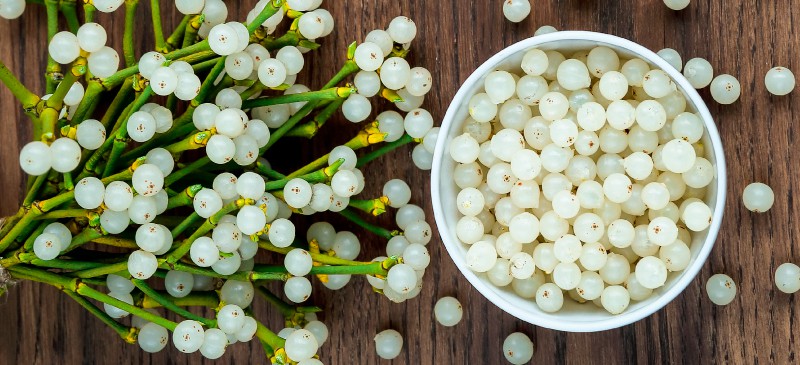
For most people, mistletoe brings to mind none other than a white Christmas. Besides serving as a festive winter decoration, did you know that mistletoe is also used in herbal medicine and has been for hundreds of years?
It’s a little known fact that there is actually more than one type of mistletoe. In fact, it’s believed over 100 different species are in existence.
One type of branch is most prominently used ornamentally, while a few are harvested for their medicinal purposes.
When it comes to health promotion and preventing common conditions, what is mistletoe used for? According to the National Center for Complimentary and Integrative Health (NCCIH), some of the many ailments that it may help treat include:
- seizures
- headaches
- arthritis symptoms
- potentially even cancer
That said, while it may have been considered a top herb for healing throughout history, there’s not much evidence showing it definitely works … and some that indicates it may be dangerous.
What Is Mistletoe?
Mistletoe is a member of the Viscaceae plant family and is considered an evergreen hemiparasitic plant. As a parasitic plant, it latches on to trees and feeds off of them.
It’s harvested for its berries, leaves and stems.
Mistletoe earned its interesting name because many years ago people noticed that it grew where bird droppings were found. In Anglo-Saxon, “mistel” means “dung” and “tan” means “twig.” The name misteltan eventually morphed to mistletoe.
Herbalists use mistletoe to make herbal extracts that have certain physiological effects.
The European plant, the type used as a supplement/medicine, grows on common trees such as apple, oak, pine and elm trees. Mistletoe plants form clusters or “bushes” on these trees, sometimes called “witches’ brooms.”
During cooler months, including throughout the winter, berries also grow on the branches, which attract a variety of birds.
Types
Mistletoe plants are distributed across Europe, America, Asia and Africa to Australia and New Zealand. Some of the most recognized mistletoe species include:
- Viscum
- Phoradendron
- Arceuthobium
- Peraxilla
- Loranthus
- Amylotheca
- Amyema
- Taxillus
- Psittacanthus
- Scurrula
American mistletoe (Phoradendron flavescens) is the type that grows in the United States and is used as a romantic holiday/Christmas decoration throughout the winter, while European mistletoe (Viscum album) is the species that has been used for centuries in traditional herbal medicine.
A third species (Loranthus ferrugineus) is less common but used by some to treat high blood pressure and gastrointestinal complaints. Other species, including Japanese mistletoe (Taxillus yadoriki Danser), are known for their many antimicrobial and antioxidant properties.
Uses in Traditional Medicine
The name “mistletoe” is believed to have been derived from the Celtic word for “all-heal.” Records tell us there were many historical uses of mistletoe, most of which focused on healing the nervous system.
It was used to treat conditions including:
- nervousness/anxiety (sometimes in combination with valerian root)
- convulsions
- hysteria
- neuralgia
- skin problems
- urinary disorders
- fevers
- heart disease
In some traditional medicine systems, it was believed to be a natural “heart tonic” that could strengthen the force of the heartbeat and increase the heart rate. Herbal formulas that included mistletoe, valerian and vervain were often given for “all kinds of nervous complaints” caused by hormonal imbalances, fatigue, etc.
As a natural remedy, mistletoe was usually made into a healing tea or tincture. Another use was making salves for skin problems like sores and ulcers.
Role as a Christmas Decoration
What does mistletoe have to do with Christmas? It has long been associated with peace, protection, romance and celebration.
Today, the meaning of the mistletoe at Christmas is to serve as a sign of love and friendship.
Why do people kiss under mistletoe? This holiday tradition is said to have first began with the Greek festival of Saturnalia. Other sources claim that this tradition started in England in churches.
Records show that it first became a symbol of romance during the times of ancient Norse mythology, practiced by North Germanic/Scandinavian people in the 17th and 18th centuries. The custom of kissing beneath the mistletoe then spread to British servants and throughout England.
Refusing to kiss someone beneath mistletoe branches was associated with bad luck, as were mistletoe plants that lost of their berries.
Historically, mistletoe also symbolized the need to form a truce among enemies. The ancient Celts and Germans used European mistletoe as a ceremonial plant and believed that it had mystical powers.
It has long been a symbol of protection from misfortune, illness and violence as it “warded off evil spirits.” Some also believed it had natural aphrodisiac properties, so it was sometimes used to promote fertility
Is It Poisonous?
Why might mistletoe be bad? Because mistletoe can sometimes wind up causing damage to “host trees” that it grows on, it’s earned a reputation as being “poisonous” and is even called a “parasite” by some.
The International Academy of Herbal Arts and Sciences states: “Mistletoe burrows roots into the inner wood of trees and feeds from their sap, and a heavy infestation with mistletoe can kill branches of the host plant or even the entire host.”
Technically mistletoes are hemiparasites, meaning they obtain some energy through photosynthesis while the rest is extracted from other trees and plants.
While mistletoe can sometimes kill trees here and there, it also supplies food for birds and provides dense foliage that is useful for nesting. In fact, forests where it grows abundantly have been found to be home to many more birds — including owls, robins, chickadees, bluebirds and mourning doves — due to their ability to eat and burrow in mistletoe bunches.
What do we know about the effectiveness and safety of mistletoe when humans consume it? Is mistletoe also a type of disease or harmful?
- It’s well-known that parts of the plant, including the berries and leaves, can cause serious side effects when consumed orally. Poisoning can also occur if you drink too much tea created from the plant. The poisonous ingredient found in mistletoe is called phoratoxin. Symptoms are most likely to occur after ingesting the leaves and usually last one to three days.
- There are also potential side effects associated with injections. Side effects that can be caused by mistletoe extract injections can include soreness, inflammation at the injection site, headache, fever, chills, skin rash and, rarely, severe allergic reactions.
- Other potential adverse reactions include vomiting, diarrhea, cramping and liver damage if used long term.
- Consuming small amounts has mostly been shown to be safe. Larger doses pose the greatest risk for serious side effects.
- All of that said, mistletoe when used as medicine seems to be generally safe. According to a 2018 statement published by the PDQ Integrative, Alternative, and Complementary Therapies Editorial Board, “few side effects have been reported from the use of mistletoe extracts.”
Overall, limited research exists on the potential side effects of consuming mistletoe. Currently in the United States, it is only used in clinical trials and not otherwise indicated for use.
Some trials have found evidence that mistletoe can help improve survival or quality of life in cancer patients. However, the vast majority of trials have had “major weaknesses that raise doubts about their findings.”
The NCCIH and the National Cancer Institute completed a preliminary trial to evaluate the safety of injected European mistletoe extract in combination with a cancer drug in patients with advanced cancer. It showed that patients seemed to tolerate the herb/drug combination.
However, future studies are still being designed to evaluate mistletoe’s effectiveness. That means for now it is still considered an unproven cancer treatment.
READ RELATED: What Might Happen If You Don’t Wash Your Bra After Each Wear
Mistletoe should not be used during pregnancy, since there are no studies to show it’s safe and some that suggest it can cause changes in the uterus that increase miscarriage risk. It also shouldn’t be used by anyone with an autoimmune disease since it might cause the immune system to become more active or anyone being treated for diabetes or heart disease/high blood pressure since it can modify glucose/blood sugar levels.
Because it’s controversial and capable of causing adverse effects, it’s best to consult with a health care practitioner before taking mistletoe.
Benefits
Studies have identified different kinds of free radical-scavenging antioxidant, antimicrobial and anti-inflammatory constituents within various mistletoe species, including:
- Flavonoids
- Alkaloids
- Lectins
- Polypeptides
- Arginine
- Polysaccharides
- Tannins
- Terpenoids and/or steroids
- Acidic compounds
- Glycosides
- Gallic acid
Because it’s rich in these protective compounds, mistletoe may have some of the following health benefits:
1. Potentially Helpful for Cancer
Today, mistletoe extracts are the most frequently prescribed unconventional cancer therapies in Germany and some other European countries, where mistletoe is sold as a prescription drug, most often for cancer.
Even though it has been used in Europe since the 1920s, the U.S. Food and Drug Administration has not approved it as a treatment for any condition, including cancer.
What does mistletoe do to possibly help fight cancer? In certain studies, it has been shown to stimulate the immune system and kill certain cancer cells. However, these effects have mostly been observed in test tubes and not in humans.
A number of in-vitro studies have reported immunostimulatory, cytotoxic and proapoptotic effects.
Unfortunately, though, almost all studies have had at least one major weakness that has made researchers question their reliability. One review even concluded: “Most studies did not show any effect of mistletoe on cancer survival.”
There is some research that suggests that administering European mistletoe extract might offer help in the treatment of:
- Breast cancer — Limited studies have found that injections might help stop breast cancer tumor growth and increase life span.
- Advanced pancreatic cancer — Mistletoe extract might be able to help improve survival time by several months when injected into the tumor in people with pancreatic cancer.
- Colon cancer
- Bladder cancer (especially in those with reoccurring bladder cancer)
- Stomach cancer
- Liver cancer
- Leukemia
- Lung cancer
- Ovarian cancer
- Uterine cancer
Another potential but controversial use is reducing side effects of cancer treatments, including chemotherapy and radiation therapy, and improving quality of life during recovery.
A 2020 systematic review published in the journal BMC Complimentary Medicine and Therapies found that “mistletoe extracts produce a significant, medium-sized effect on quality of life (QoL) in cancer.” The researchers did point out though that “most studies have a high risk of bias or at least raise some concern.”
On the other hand, a separate 2019 review did not find evidence suggesting that it had any major positive impacts on the lives of people recovering from cancer.
2. May Support Cardiovascular Health
There’s some evidence that mistletoe, especially the species L. ferrugineus and Loranthus micranthus (African mistletoe), may help manage hypertension and gastrointestinal complaints. These types may lower the risk for blood vessel conditions, including high blood pressure and atherosclerosis (thickening and hardening of the arteries).
A 2011 study published in Biochemistry Research International that was conducted on rats found that it had anti-hypertensive, anti-artherogenic and vasorelaxation effects that could potentially reduce cardiac episodes. However, study results have been mixed overall. Some even suggest it may make heart disease worse in certain patients.
3. Used Topically to Manage Skin Conditions
Sprigs of mistletoe can be used for bathing. You can also apply it to the skin to help treat varicose veins, ulcers on the lower legs and eczema.
Some also believe that it has pain-killing properties and can be used to help treat joint pain (rheumatic and neuralgic pains) when it’s rubbed into the skin.
4. May Help Treat Depression and Anxiety
Mistletoes have emerged as promising alternative therapy against mood-related conditions, including depression, anxiety and fatigue, especially when these conditions are associated with cancer treatments.
Several studies have shown that mistletoe can improve coping ability of both cancer patients and survivors.
5. May Support Hormonal Balance
Mistletoe has been used to help manage menopause symptoms, such as fatigue and trouble sleeping, and to regulate hormones when a woman experiences irregular periods.
In post-menopausal women, the population most likely to suffer from osteoporosis, it may also be able to help defend against weak bones and fractures.
6. Used to Fight Colds, Coughs and Asthma
Although not many studies have directly observed mistletoe’s effects on the respiratory system, various mistletoe plant species are believed to exert antioxidant, analgesic, anti-inflammatory and immune-stimulatory properties, making them defenders against illnesses and infections.
Supplementing with mistletoe might be able to help fight off common colds, sore throats, fevers, coughs and respiratory issues like asthma, although this hasn’t been proven in many studies.
To defend against respiratory issues and colds, sprigs of mistletoe can be used to make herbal tea/tinctures or they can be inhaled.
Mistletoe vs. Holly
- Like certain species of mistletoe, holly (Ilex aquifolium) is a plant also widely used for decoration in the winter, especially during Christmas. These two plants are commonly used together, but they don’t look alike or have the same chemical properties.
- Just like with mistletoe, there are many species of holly. English holly, Oregon holly and American holly are used as ornamental Christmas greens. These types of holly plants are shrubs that have spiky, dark-green, thin, glossy leaves and red berries.
- The leaves of the holly species llex opaca, Ilex vomitoria and Ilex aquifolium are used to make medicine. Their berries are said to be “poisonous” because they can cause serious side effects if eaten.
- Some of the conditions that holly is said to help treat include coughs, digestive disorders, jaundice, fevers, joint pain, swelling, water retention, heart disease and high blood pressure.
- Traditional uses of holly include consuming it as a heart tonic and digestive cleanser, since it has properties that can induce vomiting and change blood pressure.
How to Use
Once dried and made into an extract, mistletoe is typically given as an injection. It can, however, also be taken by mouth as a capsule/supplement and consumed as a tea/tincture.
Mistletoe is usually sold as a dry herb or as sprigs. At home, dried mistletoe can be used to make teas and tinctures.
It’s recommended that tea made from the mistletoe always be made as a cold infusion, since using very hot water may destroy some of the compounds found in mistletoe. For most people, the easiest way to make mistletoe tea it with with hot but not boiling water (like you could make green tea).
It’s also possible to take the extract by mouth. Depending on which country you live in, a doctor may prescribe extract injections.
Because products vary, always read directions carefully when purchasing mistletoe herb. Speak to your doctor if you take any medications, especially those for high blood pressure, since mistletoe does have a number of interactions with other drugs.
Dosage Recommendations:
- Use the smallest possible dose that exerts an obvious effect. Some herbalists use only one to two milliliters of extract per day in divided doses. Low doses of one milliliter per day are even used by some doctors as a complementary cancer treatment.
- Crude mistletoe fruit or herb used to make tea (typically to treat hypertension) is recommended at a dosage of 10 grams per day.
- Extracts are usually given by intravenous or subcutaneous injection at dosages of 0.1 to 30 milligrams, several times per week.
Mistletoe Injections
The effectiveness of mistletoe injections depends on the exact type of extract being used. Products can vary considerably, since many factors affect the quality of the extract. These include the type of host tree, the exact species, how the extract is gathered and the time of year the plant is picked.
Extracts are made in water-based solutions (made with water and alcohol) that are commonly injected. Products are sometimes named according to the type of tree on which the plant grows.
As mentioned above, subcutaneous mistletoe injections (those administered below the skin) are only approved for use in clinical trials in the U.S at this time. Usually, injections are given under the skin. Sometimes they can be administered into a vein, pleural cavity or a tumor.
In countries other than the U.S., there are several brands of extracts/injections that are currently available by prescription, including:
- Iscador
- Eurixor
- Helixor
- Isorel
- Vysorel
- ABNOBAviscum
While some in-vitro studies have demonstrated growth inhibition, cell death and anti-tumor activity in cancer patients using mistletoe extract, the consensus in the U.S. is that there still isn’t solid evidence for its effectiveness.
Conclusion
- Mistletoe is a member of the Viscaceae plant family and is considered an evergreen hemiparasitic plant. It’s used to make herbal extracts and medicines, including injections.
- There are more than 100 species that grow around the world. American mistletoe (Phoradendron flavescen) is the type that grows in the United States and is used as a romantic Christmas/holiday decoration. Kissing under the mistletoe represents peace and romance. European mistletoe (Viscum album) is the species that has been used for centuries in traditional herbal medicine.
- Benefits include potentially helping against cancer, improving cardiovascular health, managing skin conditions, alleviating depression/anxiety, balancing hormones and fighting colds/fevers/respiratory issues. Injections are widely used in Europe to help with cancer. They aren’t yet approved in the U.S. due to a lack of reliable information from existing clinical trials.
- While studies suggest it’s generally well-tolerated, products vary from brand to brand depending on many factors. Side effects like fever, chills, skin rash, diarrhea, headaches and allergic reactions are possible.
Source:








